Ventilator Discontinuation: The evidence base and “best practice”

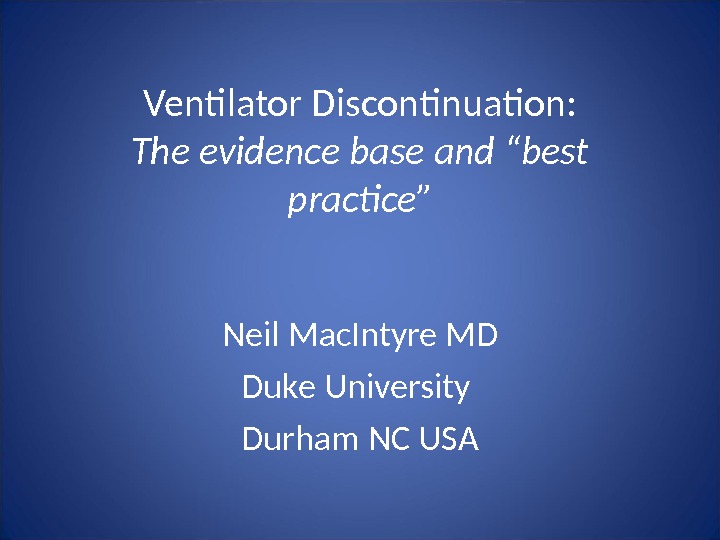

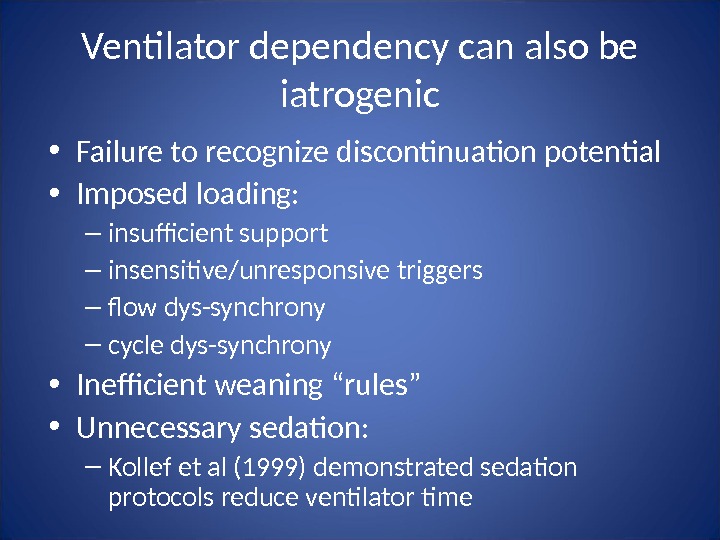

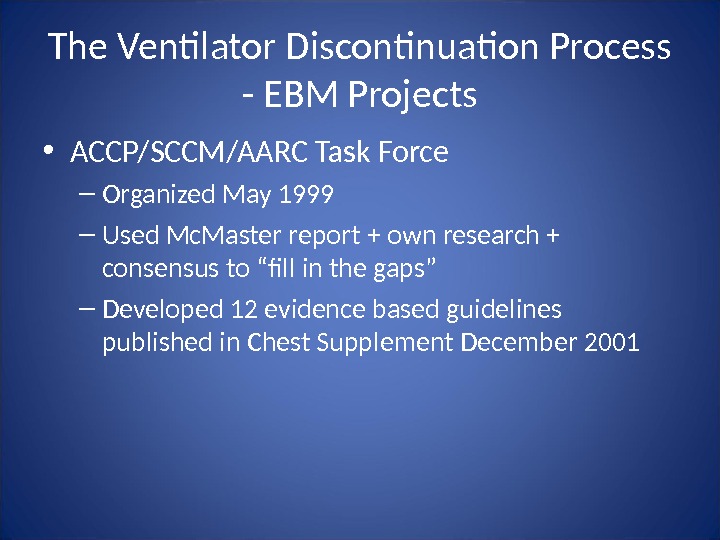
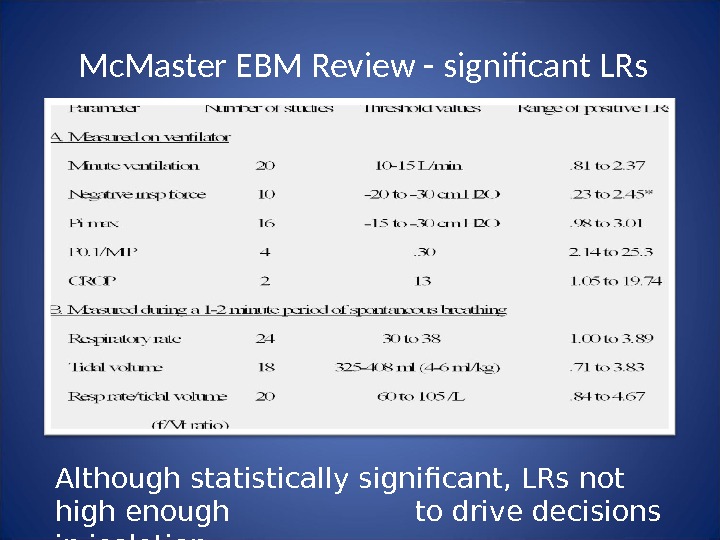
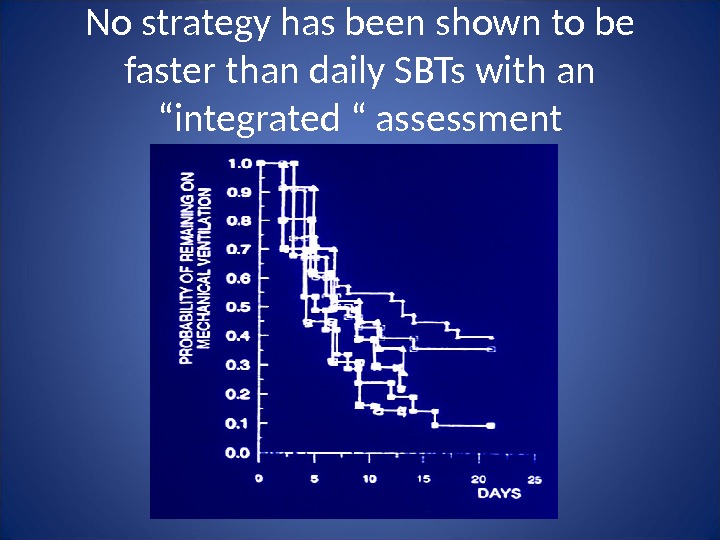
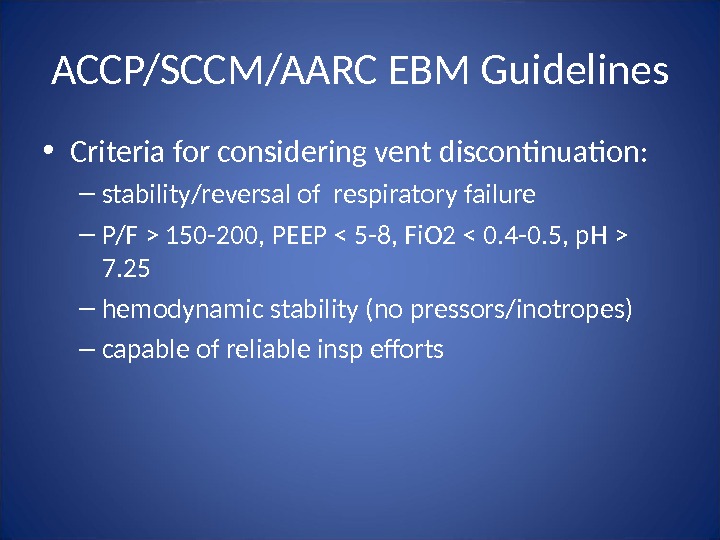
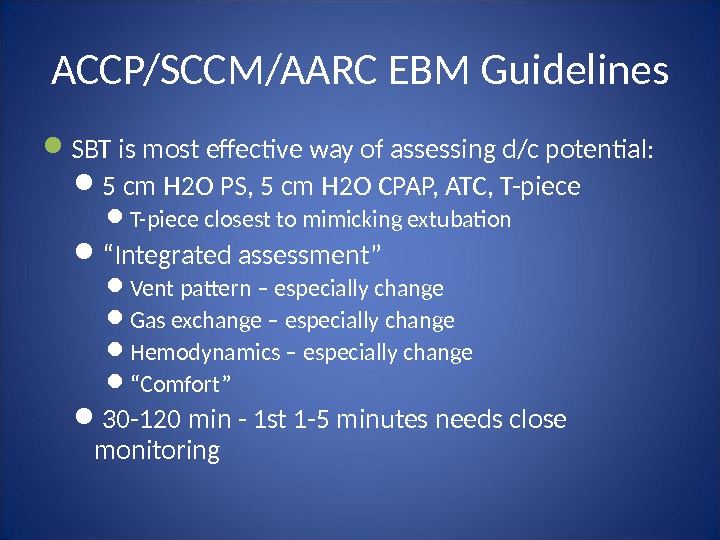
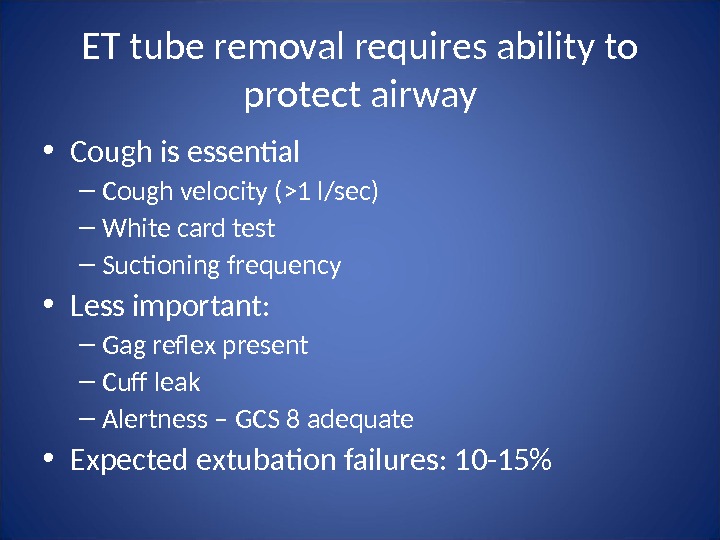

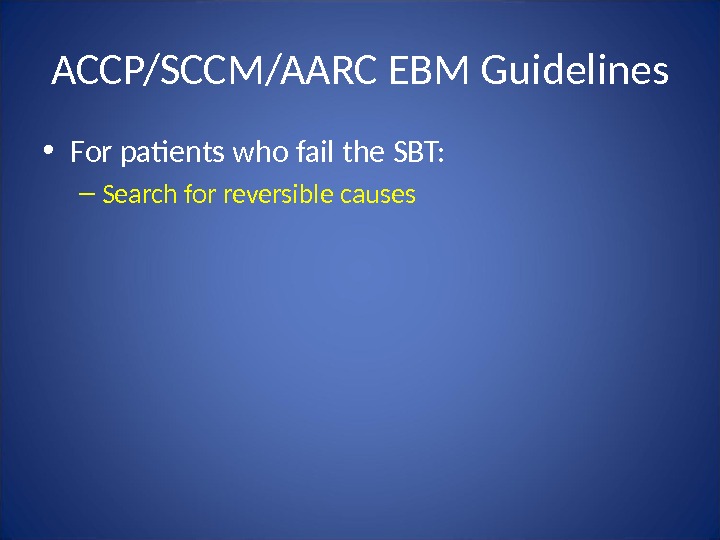

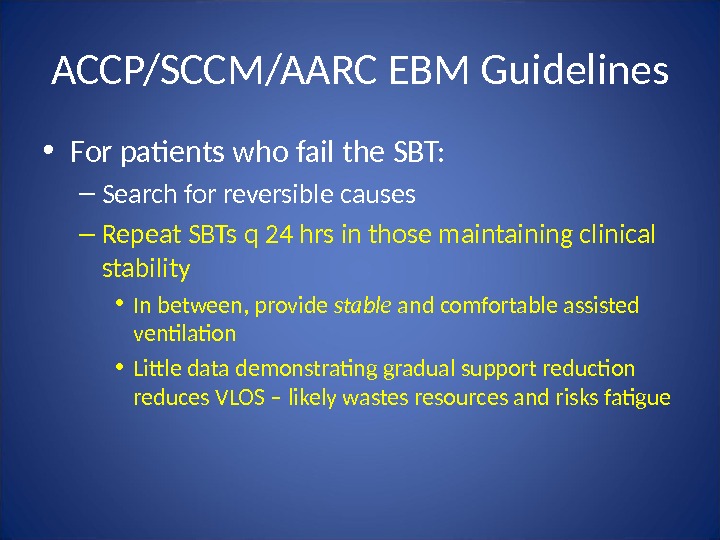





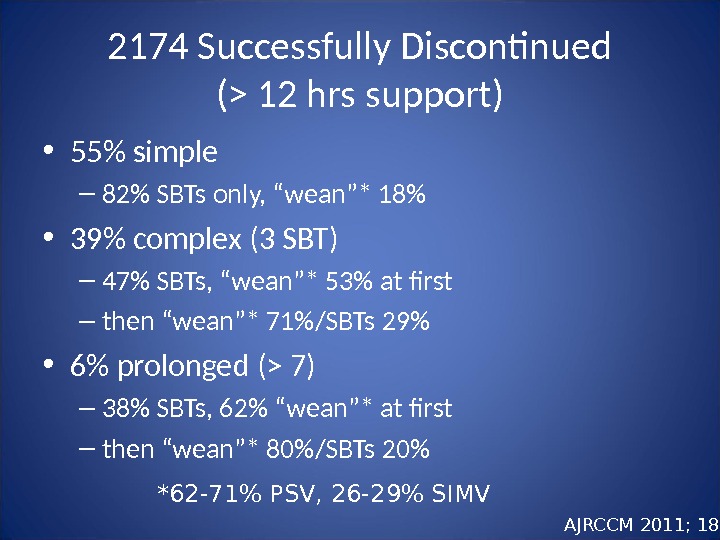



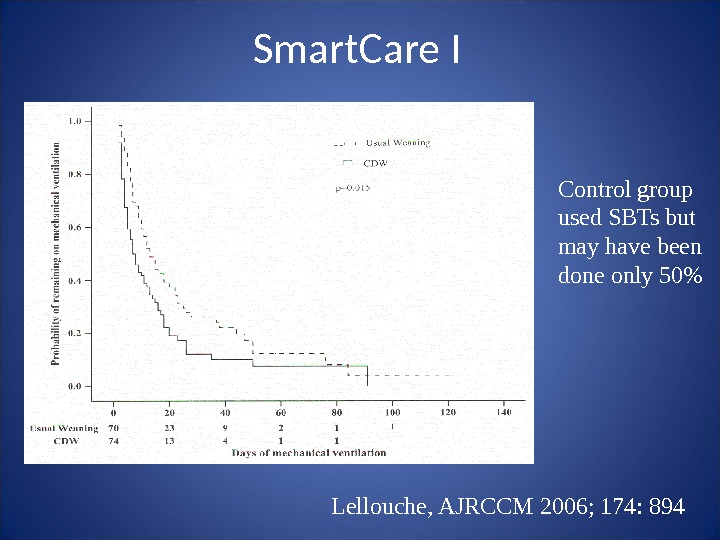



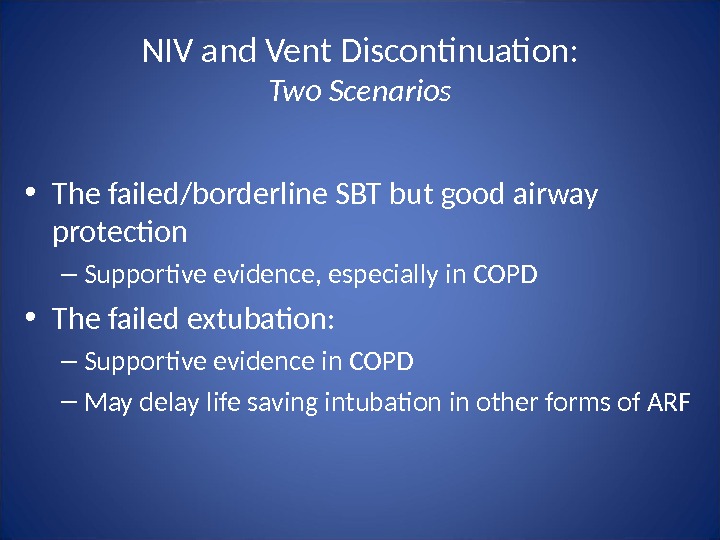
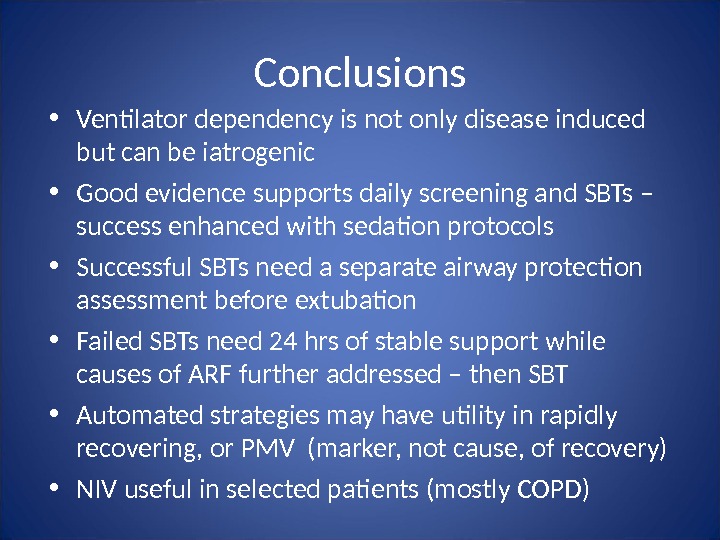
russia_-_vent_discontinuation_process.ppt
- Размер: 1.4 Mегабайта
- Количество слайдов: 29
Описание презентации Ventilator Discontinuation: The evidence base and “best practice” по слайдам
 Ventilator Discontinuation: The evidence base and “best practice” Neil Mac. Intyre MD Duke University Durham NC US
Ventilator Discontinuation: The evidence base and “best practice” Neil Mac. Intyre MD Duke University Durham NC US
 Ventilator dependency reflects an imbalance in loads/capacities
Ventilator dependency reflects an imbalance in loads/capacities
 Ventilator dependency can also be iatrogenic • Failure to recognize discontinuation potential • Imposed loading: – insufficient support – insensitive/unresponsive triggers – flow dys-synchrony – cycle dys-synchrony • Inefficient weaning “rules” • Unnecessary sedation: – Kollef et al (1999) demonstrated sedation protocols reduce ventilator time
Ventilator dependency can also be iatrogenic • Failure to recognize discontinuation potential • Imposed loading: – insufficient support – insensitive/unresponsive triggers – flow dys-synchrony – cycle dys-synchrony • Inefficient weaning “rules” • Unnecessary sedation: – Kollef et al (1999) demonstrated sedation protocols reduce ventilator time
 The Ventilator Discontinuation Process — EBM Projects • AHCPR — Mc. Master comprehensive evidence based review – 5000 papers screened – Over 150 quality trials systematically analyzed – Published Nov
The Ventilator Discontinuation Process — EBM Projects • AHCPR — Mc. Master comprehensive evidence based review – 5000 papers screened – Over 150 quality trials systematically analyzed – Published Nov
 The Ventilator Discontinuation Process — EBM Projects • ACCP/SCCM/AARC Task Force – Organized May 1999 – Used Mc. Master report + own research + consensus to “fill in the gaps” – Developed 12 evidence based guidelines published in Chest Supplement December
The Ventilator Discontinuation Process — EBM Projects • ACCP/SCCM/AARC Task Force – Organized May 1999 – Used Mc. Master report + own research + consensus to “fill in the gaps” – Developed 12 evidence based guidelines published in Chest Supplement December
 Mc. Master EBM Review — significant LRs Although statistically significant, LRs not high enough to drive decisions in isolation
Mc. Master EBM Review — significant LRs Although statistically significant, LRs not high enough to drive decisions in isolation
 No strategy has been shown to be faster than daily SBTs with an “integrated “ assessment
No strategy has been shown to be faster than daily SBTs with an “integrated “ assessment
 ACCP/SCCM/AARC EBM Guidelines • Criteria for considering vent discontinuation: – stability/reversal of respiratory failure – P/F > 150 -200, PEEP < 5 -8, Fi. O 2 7. 25 – hemodynamic stability (no pressors/inotropes) – capable of reliable insp efforts
ACCP/SCCM/AARC EBM Guidelines • Criteria for considering vent discontinuation: – stability/reversal of respiratory failure – P/F > 150 -200, PEEP < 5 -8, Fi. O 2 7. 25 – hemodynamic stability (no pressors/inotropes) – capable of reliable insp efforts
 ACCP/SCCM/AARC EBM Guidelines SBT is most effective way of assessing d/c potential: 5 cm H 2 O PS, 5 cm H 2 O CPAP, ATC, T-piece closest to mimicking extubation “ Integrated assessment” Vent pattern – especially change Gas exchange – especially change Hemodynamics – especially change “ Comfort” 30 -120 min — 1 st 1 -5 minutes needs close monitoring
ACCP/SCCM/AARC EBM Guidelines SBT is most effective way of assessing d/c potential: 5 cm H 2 O PS, 5 cm H 2 O CPAP, ATC, T-piece closest to mimicking extubation “ Integrated assessment” Vent pattern – especially change Gas exchange – especially change Hemodynamics – especially change “ Comfort” 30 -120 min — 1 st 1 -5 minutes needs close monitoring
 ET tube removal requires ability to protect airway • Cough is essential – Cough velocity (>1 l/sec) – White card test – Suctioning frequency • Less important: – Gag reflex present – Cuff leak – Alertness – GCS 8 adequate • Expected extubation failures: 10 -15%
ET tube removal requires ability to protect airway • Cough is essential – Cough velocity (>1 l/sec) – White card test – Suctioning frequency • Less important: – Gag reflex present – Cuff leak – Alertness – GCS 8 adequate • Expected extubation failures: 10 -15%
 Routine daily SBTs shortens weaning NEJM 1996; 335:
Routine daily SBTs shortens weaning NEJM 1996; 335:
 ACCP/SCCM/AARC EBM Guidelines • For patients who fail the SBT: – Search for reversible causes
ACCP/SCCM/AARC EBM Guidelines • For patients who fail the SBT: – Search for reversible causes
 In between the daily SBT: • Address the reversible aspects of load/capabilities imbalance: – Loads: • improve mechanics (edema, airways) • metabolic demands – Capabilities • nutrients/electrolytes • provide adequate DO 2 to vent muscles (CO*, Hb) • adrenal function • SEDATION STRATEGIES – SAT vs targeted protocols? *removal of intrathoracic pressure may precipitate heart failure
In between the daily SBT: • Address the reversible aspects of load/capabilities imbalance: – Loads: • improve mechanics (edema, airways) • metabolic demands – Capabilities • nutrients/electrolytes • provide adequate DO 2 to vent muscles (CO*, Hb) • adrenal function • SEDATION STRATEGIES – SAT vs targeted protocols? *removal of intrathoracic pressure may precipitate heart failure
 ACCP/SCCM/AARC EBM Guidelines • For patients who fail the SBT: – Search for reversible causes – Repeat SBTs q 24 hrs in those maintaining clinical stability • In between, provide stable and comfortable assisted ventilation • Little data demonstrating gradual support reduction reduces VLOS – likely wastes resources and risks fatigue
ACCP/SCCM/AARC EBM Guidelines • For patients who fail the SBT: – Search for reversible causes – Repeat SBTs q 24 hrs in those maintaining clinical stability • In between, provide stable and comfortable assisted ventilation • Little data demonstrating gradual support reduction reduces VLOS – likely wastes resources and risks fatigue
 In between daily SBTs • Properly load the muscles: – “ Normalize” amount of load • avoid atrophy, avoid fatigue – “ Optimize” comfort with synchronous flow delivery throughout the breath • sensitive/responsive triggering • responsive (variable) flow with EVERY breath • proper breath termination (cycling) • Maintain this level without change until next SBT • “ Weaning” this level has never been shown to improve outcomes
In between daily SBTs • Properly load the muscles: – “ Normalize” amount of load • avoid atrophy, avoid fatigue – “ Optimize” comfort with synchronous flow delivery throughout the breath • sensitive/responsive triggering • responsive (variable) flow with EVERY breath • proper breath termination (cycling) • Maintain this level without change until next SBT • “ Weaning” this level has never been shown to improve outcomes
 Practical aspects of “normalized”, comfortable loading • Triggering — max sensitivity, “balance” PEEPi with applied PEEP • Pressure/flow targets – Variable flow easier to synchronize with effort — therefore pressure targeted modes (PS, PA) best – Operational pressure range 10 -25 cm H 2 O — start at 15 and titrate to breathing pattern, comfort • Cycling — PS uses flow, PA uses time — adjust to comfortable I:
Practical aspects of “normalized”, comfortable loading • Triggering — max sensitivity, “balance” PEEPi with applied PEEP • Pressure/flow targets – Variable flow easier to synchronize with effort — therefore pressure targeted modes (PS, PA) best – Operational pressure range 10 -25 cm H 2 O — start at 15 and titrate to breathing pattern, comfort • Cycling — PS uses flow, PA uses time — adjust to comfortable I:
 Newer approaches to improving synchrony • Proportional assist ventilation – Pressure and flow driven by sensed pt flow • Neurally adjusted ventilator assistance – Pressure and flow driven by diaphragm EMG All have theoretical appeal and have been shown to support patient effort – However, no meaningful outcome data
Newer approaches to improving synchrony • Proportional assist ventilation – Pressure and flow driven by sensed pt flow • Neurally adjusted ventilator assistance – Pressure and flow driven by diaphragm EMG All have theoretical appeal and have been shown to support patient effort – However, no meaningful outcome data
 ACCP/SCCM/AARC EBM Guidelines • For patients who fail the SBT: – Search for reversible causes – Repeat SBTs q 24 hrs in those maintaining clinical stability • Stable comfortable support – no need to “wean”
ACCP/SCCM/AARC EBM Guidelines • For patients who fail the SBT: – Search for reversible causes – Repeat SBTs q 24 hrs in those maintaining clinical stability • Stable comfortable support – no need to “wean”
 ACCP/SCCM/AARC EBM Guidelines • For patients who fail the SBT: – Search for reversible causes – Repeat SBTs q 24 hrs in those maintaining clinical stability • Stable comfortable support – no need to “wean” Is this what is happening?
ACCP/SCCM/AARC EBM Guidelines • For patients who fail the SBT: – Search for reversible causes – Repeat SBTs q 24 hrs in those maintaining clinical stability • Stable comfortable support – no need to “wean” Is this what is happening?
 2174 Successfully Discontinued (> 12 hrs support) • 55% simple – 82% SBTs only, “wean”* 18% • 39% complex (3 SBT) – 47% SBTs, “wean”* 53% at first – then “wean”* 71%/SBTs 29% • 6% prolonged (> 7) – 38% SBTs, 62% “wean”* at first – then “wean”* 80%/SBTs 20% *62 -71% PSV, 26 -29% SIMV AJRCCM 2011; 184:
2174 Successfully Discontinued (> 12 hrs support) • 55% simple – 82% SBTs only, “wean”* 18% • 39% complex (3 SBT) – 47% SBTs, “wean”* 53% at first – then “wean”* 71%/SBTs 29% • 6% prolonged (> 7) – 38% SBTs, 62% “wean”* at first – then “wean”* 80%/SBTs 20% *62 -71% PSV, 26 -29% SIMV AJRCCM 2011; 184:
 Can weaning be automated? • Assumes that gradual support reductions help – evidence supporting this is weak Pressure support reductions based on various feedback algorithms – VS – target VT – Smart Care – target VT, MV, ETCO
Can weaning be automated? • Assumes that gradual support reductions help – evidence supporting this is weak Pressure support reductions based on various feedback algorithms – VS – target VT – Smart Care – target VT, MV, ETCO
 Volume Support (VS, ASV) • Adjusts pressure to targeted tidal volume • In theory: – As patient recovers, bigger VT, VS drops PS • In practice: – Too high a VT selected – no PS reductions – Too low a VT selected – patient overloaded – Transient increased efforts from pain/anxiety leads to inappropriate PS reduction • NO outcome data
Volume Support (VS, ASV) • Adjusts pressure to targeted tidal volume • In theory: – As patient recovers, bigger VT, VS drops PS • In practice: – Too high a VT selected – no PS reductions – Too low a VT selected – patient overloaded – Transient increased efforts from pain/anxiety leads to inappropriate PS reduction • NO outcome data
 Lellouche, AJRCCM 2006; 174: 894 Smart. Care I
Lellouche, AJRCCM 2006; 174: 894 Smart. Care I
 Lellouche, AJRCCM 2006; 174: 894 Control group used SBTs but may have been done only 50%Smart. Care I
Lellouche, AJRCCM 2006; 174: 894 Control group used SBTs but may have been done only 50%Smart. Care I
 Int Care Med 2008; 34: 1788 Smart. Care II
Int Care Med 2008; 34: 1788 Smart. Care II
 So is there a role for automatic PS reductions? • No evidence that says this facilitates muscle recovery • Patient tolerance to decreasing PS could signal clinicians to initiate SBTs (weaning and weaning success diagnostic, not therapeutic): – Rapidly recovering patient (overdose, post op) – Slowly recovering after many failed SBTs (PMV population)
So is there a role for automatic PS reductions? • No evidence that says this facilitates muscle recovery • Patient tolerance to decreasing PS could signal clinicians to initiate SBTs (weaning and weaning success diagnostic, not therapeutic): – Rapidly recovering patient (overdose, post op) – Slowly recovering after many failed SBTs (PMV population)
 Gold. Seal. Mirage IQ Soft. Fit Simplicity Spectrum Breeze Phantom Total face mask
Gold. Seal. Mirage IQ Soft. Fit Simplicity Spectrum Breeze Phantom Total face mask
 NIV and Vent Discontinuation: Two Scenarios • The failed/borderline SBT but good airway protection – Supportive evidence, especially in COPD • The failed extubation: – Supportive evidence in COPD – May delay life saving intubation in other forms of AR
NIV and Vent Discontinuation: Two Scenarios • The failed/borderline SBT but good airway protection – Supportive evidence, especially in COPD • The failed extubation: – Supportive evidence in COPD – May delay life saving intubation in other forms of AR
 Conclusions • Ventilator dependency is not only disease induced but can be iatrogenic • Good evidence supports daily screening and SBTs – success enhanced with sedation protocols • Successful SBTs need a separate airway protection assessment before extubation • Failed SBTs need 24 hrs of stable support while causes of ARF further addressed – then SBT • Automated strategies may have utility in rapidly recovering, or PMV (marker, not cause, of recovery) • NIV useful in selected patients (mostly COPD)
Conclusions • Ventilator dependency is not only disease induced but can be iatrogenic • Good evidence supports daily screening and SBTs – success enhanced with sedation protocols • Successful SBTs need a separate airway protection assessment before extubation • Failed SBTs need 24 hrs of stable support while causes of ARF further addressed – then SBT • Automated strategies may have utility in rapidly recovering, or PMV (marker, not cause, of recovery) • NIV useful in selected patients (mostly COPD)

